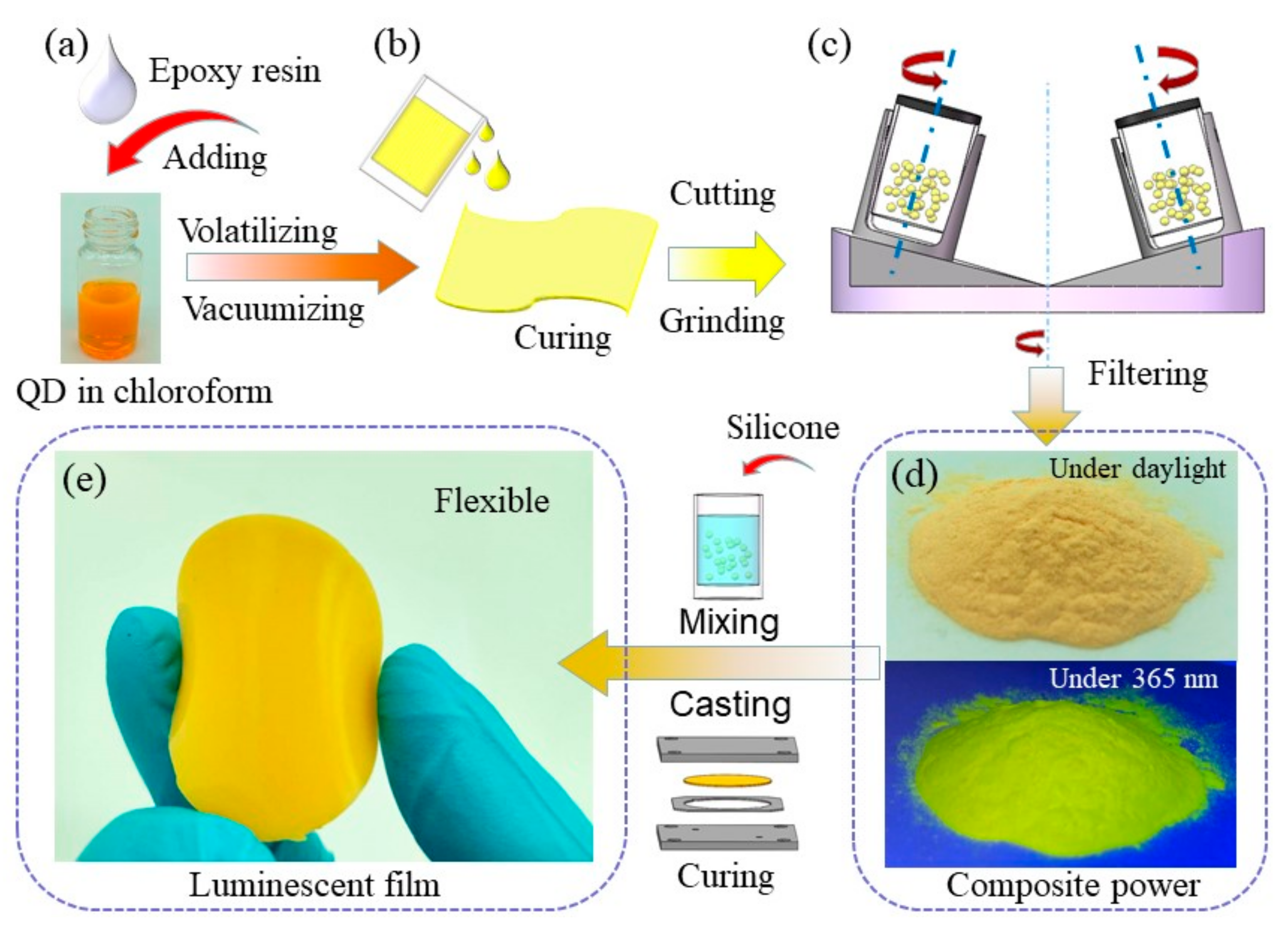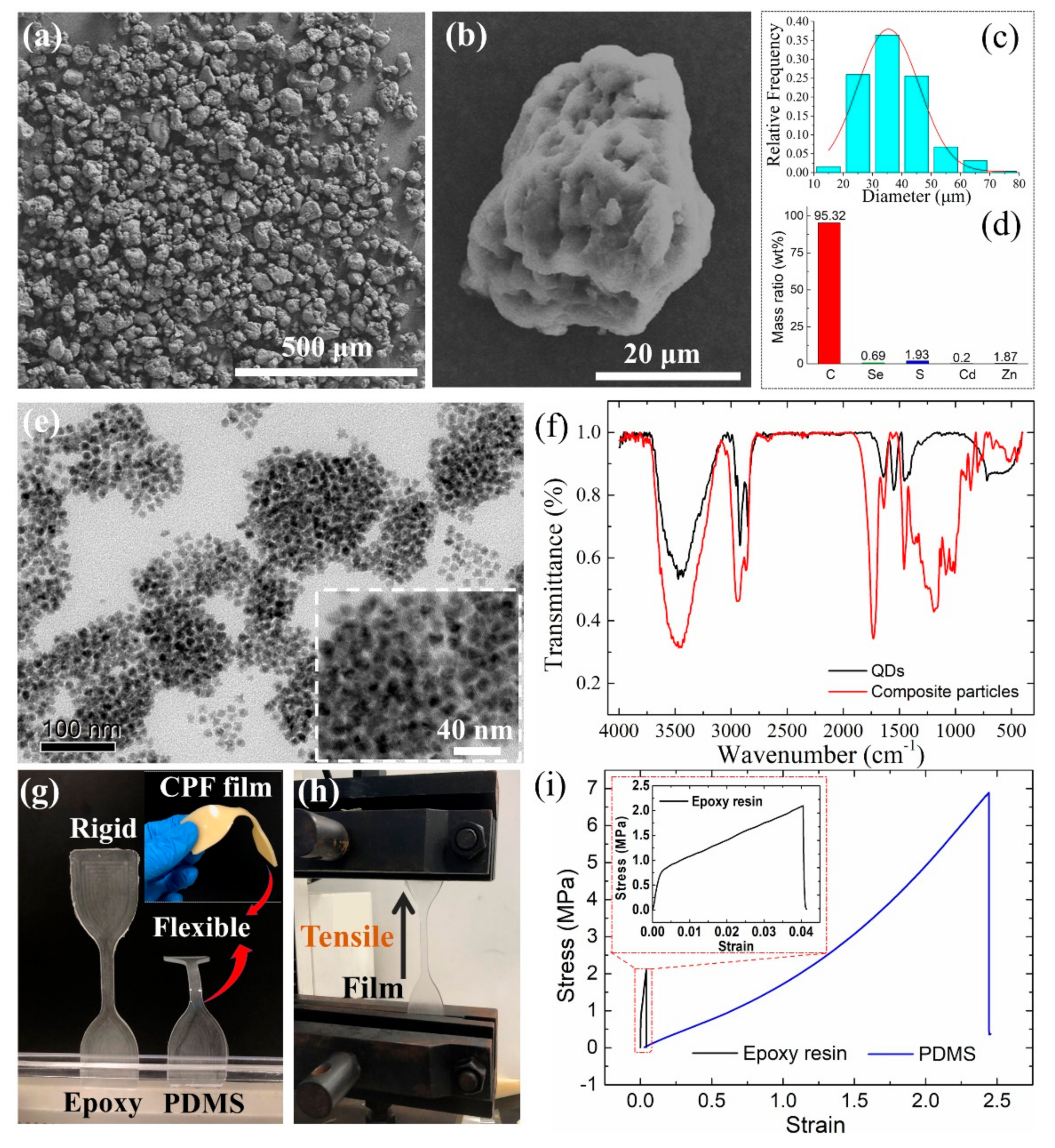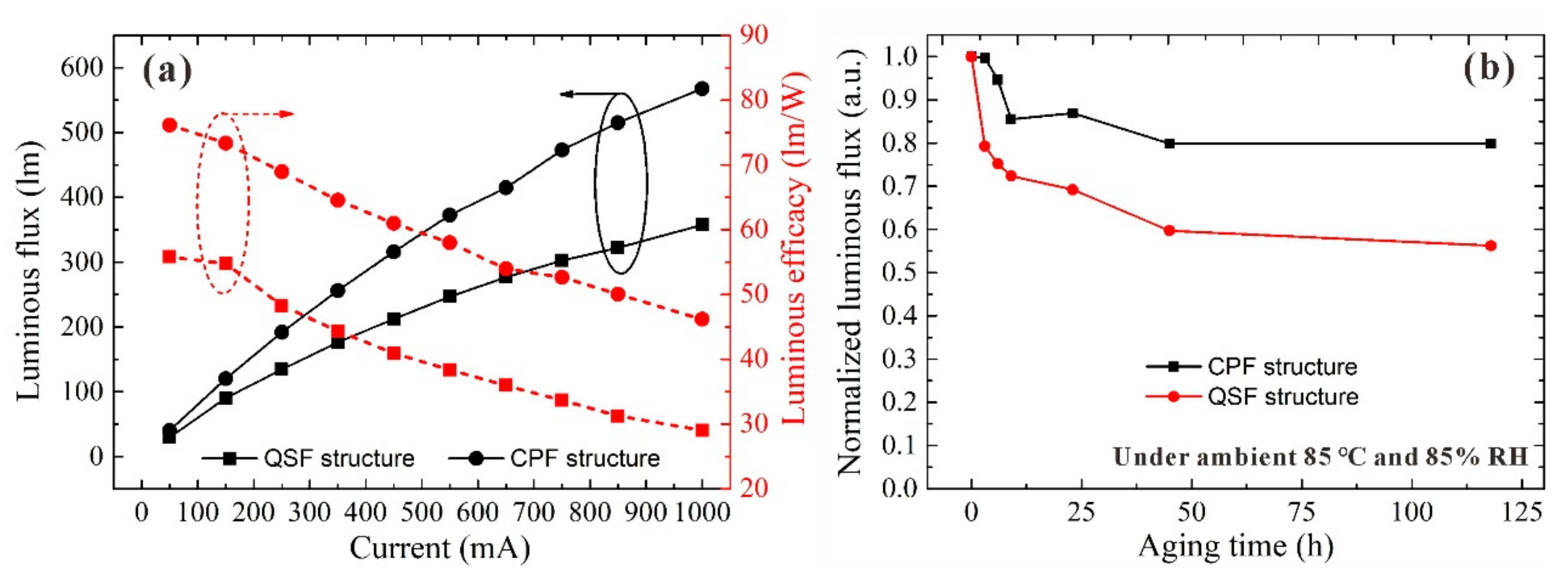Optical Performance and Moisture Stability Enhancement of Flexible Luminescent Films Based on Quantum-Dot/Epoxy Composite Particles
Abstract
:1. Introduction
2. Experimental and Measurement
2.1. Composite Particles Preparation
2.2. Fabrication of Flexible Luminescent Films
2.3. Characterizations and Measurements
3. Results and Discussions
4. Conclusions
Author Contributions
Funding
Institutional Review Board Statement
Informed Consent Statement
Data Availability Statement
Acknowledgments
Conflicts of Interest
References
- Xie, B.; Liu, H.; Hu, R.; Wang, C.; Hao, J.; Wang, K.; Luo, X. White-Light-Emitting Diodes: Targeting Cooling for Quantum Dots in White QDs-LEDs by Hexagonal Boron Nitride Platelets with Electrostatic Bonding (Adv. Funct. Mater. 30/2018). Adv. Funct. Mater. 2018, 28, 1871407. [Google Scholar] [CrossRef] [Green Version]
- Yu, S.; Tang, Y.; Li, Z.; Chen, K.; Ding, X.; Yu, B. Enhanced optical and thermal performance of white light-emitting diodes with horizontally layered quantum dots phosphor nanocomposites. Photonics Res. 2018, 6, 90. [Google Scholar] [CrossRef]
- Liu, W.; Zhang, Y.; Wang, C.-F.; Chen, S. Fabrication of highly fluorescent CdSe quantum dots via solvent-free microfluidic spinning microreactors. RSC Adv. 2015, 5, 107804–107810. [Google Scholar] [CrossRef]
- Das, P.; Ganguly, S.; Banerjee, S.; Das, N.C. Graphene based emergent nanolights: A short review on the synthesis, properties and application. Res. Chem. Intermed. 2019, 45, 3823–3853. [Google Scholar] [CrossRef]
- Ganguly, S.; Das, P.; Banerjee, S.; Das, N.C. Advancement in science and technology of carbon dot-polymer hybrid composites: A review. Funct. Compos. Struct. 2019, 1, 022001. [Google Scholar] [CrossRef]
- Das, P.; Maruthapandi, M.; Saravanan, A.; Natan, M.; Jacobi, G.; Banin, E.; Gedanken, A. Carbon Dots for Heavy-Metal Sensing, pH-Sensitive Cargo Delivery, and Antibacterial Applications. ACS Appl. Nano Mater. 2020, 3, 11777–11790. [Google Scholar] [CrossRef]
- Lee, H.; Kim, Y.H.; Lim, Y.W.; Jang, J.; Kang, S.M.; Bae, B.S. Flexible but mechanically robust hazy quantum dot/glass fiber reinforced film for efficiently luminescent surface light source. Adv. Opt. Mater. 2020, 8, 1902178. [Google Scholar] [CrossRef]
- Yan, C.; Du, X.; Li, J.; Ding, X.; Li, Z.; Tang, Y. Effect of Excitation Wavelength on Optical Performances of Quantum-Dot-Converted Light-Emitting Diode. Nanomaterials 2019, 9, 1100. [Google Scholar] [CrossRef] [Green Version]
- Woo, J.Y.; Kim, K.N.; Jeong, S.; Han, C.-S. Thermal behavior of a quantum dot nanocomposite as a color converting material and its application to white LED. Nanotechnology 2010, 21, 495704. [Google Scholar] [CrossRef] [PubMed]
- Li, J.S.; Tang, Y.; Li, Z.T.; Li, J.X.; Ding, X.R.; Yu, B.H.; Yu, S.D.; Ou, J.Z.; Kuo, H.C. Toward 200 lumens per watt of quantum-dot white-light-emitting diodes by reducing reabsorption loss. ACS Nano 2021, 15, 550–562. [Google Scholar] [CrossRef]
- Song, H.; Lee, S. Photoluminescent (CdSe)Zns quantum dot–polymethylmethacrylate polymer composite thin films in the visible spectral range. Nanotechnology 2007, 18, 55402–55406. [Google Scholar] [CrossRef]
- Li, J.; Tang, Y.; Li, Z.; Ding, X.; Rao, L.; Yu, B. Investigation of stability and optical performance of quantum-dot-based leds with methyl-terminated-pdms-based liquid-type packaging structure. Opt. Lett. 2019, 44, 90–93. [Google Scholar] [CrossRef]
- Kim, H.Y.; Yoon, D.-E.; Jang, J.; Lee, D.; Choi, G.-M.; Chang, J.H.; Lee, J.Y.; Lee, D.C.; Bae, B.-S. Quantum Dot/Siloxane Composite Film Exceptionally Stable against Oxidation under Heat and Moisture. J. Am. Chem. Soc. 2016, 138, 16478–16485. [Google Scholar] [CrossRef]
- Xie, B.; Chen, W.; Hao, J.; Wu, D.; Yu, X.; Chen, Y.; Hu, R.; Wang, K.; Luo, X. Structural optimization for remote white light-emitting diodes with quantum dots and phosphor: Packaging sequence matters. Opt. Express 2016, 24, A1560–A1570. [Google Scholar] [CrossRef] [PubMed]
- Milla, M.J.; Ulloa, J.M.; Guzmán, Á. Strong Influence of the Humidity on the Electrical Properties of InGaAs Surface Quantum Dots. ACS Appl. Mater. Interfaces 2014, 6, 6191–6195. [Google Scholar] [CrossRef] [PubMed]
- Martín-García, B.; Bi, Y.; Prato, M.; Spirito, D.; Krahne, R.; Konstantatos, G.; Moreels, I. Reduction of moisture sensitivity of PbS quantum dot solar cells by incorporation of reduced graphene oxide. Sol. Energy Mater. Sol. Cells 2018, 183, 1–7. [Google Scholar] [CrossRef] [Green Version]
- Jo, J.H.; Kim, M.S.; Han, C.Y.; Jang, E.P.; Do, Y.R.; Yang, H. Effective surface passivation of multi-shelled inp quantum dots through a simple complexing with titanium species. Appl. Surf. Sci. 2017, 428, 906–911. [Google Scholar] [CrossRef]
- Kwon, Y.-T.; Choi, Y.-M.; Kim, K.-H.; Lee, C.-G.; Lee, K.-J.; Kim, B.-S.; Choa, Y.-H. Synthesis of CdSe/ZnSe quantum dots passivated with a polymer for oxidation prevention. Surf. Coatings Technol. 2014, 259, 83–86. [Google Scholar] [CrossRef]
- Jang, J.; Kim, S.; Lee, K.J. Fabrication of CdS/PMMA core/shell nanoparticles by dispersion mediated interfacial polymerization. Chem. Commun. 2007, 26, 2689–2691. [Google Scholar] [CrossRef]
- Xuan, T.; Huang, J.; Liu, H.; Lou, S.; Cao, L.; Gan, W.; Liu, R.-S.; Wang, J. Super-Hydrophobic Cesium Lead Halide Perovskite Quantum Dot-Polymer Composites with High Stability and Luminescent Efficiency for Wide Color Gamut White Light-Emitting Diodes. Chem. Mater. 2019, 31, 1042–1047. [Google Scholar] [CrossRef]
- Dirin, D.; Protesescu, L.; Trummer, D.; Kochetygov, I.; Yakunin, S.; Krumeich, F.; Stadie, N.; Kovalenko, M.V. Harnessing Defect-Tolerance at the Nanoscale: Highly Luminescent Lead Halide Perovskite Nanocrystals in Mesoporous Silica Matrixes. Nano Lett. 2016, 16, 5866–5874. [Google Scholar] [CrossRef] [PubMed]
- Li, J.; Tang, Y.; Li, Z.; Ding, X.; Yu, B.; Lin, L. Largely enhancing luminous efficacy, color-conversion efficiency, and stability for quantum-dot white leds using the two-dimensional hexagonal pore structure of sba-15 mesoporous particles. ACS Appl. Mater. Interfaces 2019, 11, 18808–18816. [Google Scholar] [CrossRef] [PubMed]
- Yu, X.; Pei, N.; Zhou, S.; Zhang, X.; Luo, X. Enhancing light efficiency and moisture stability of the quantum dots-light-emitting diodes by coating superhydrophobic nanosilica particles. IEEE Trans. Electron. Devices 2019, 66, 5196–5201. [Google Scholar] [CrossRef]
- Lin, C.C.; Jiang, D.-H.; Kuo, C.-C.; Cho, C.-J.; Tsai, Y.-H.; Satoh, T.; Su, C. Water-Resistant Efficient Stretchable Perovskite-Embedded Fiber Membranes for Light-Emitting Diodes. ACS Appl. Mater. Interfaces 2018, 10, 2210–2215. [Google Scholar] [CrossRef]
- Xie, A.; Cui, T.; Cheng, R.; Wu, X.; Guo, J.; Lu, X.; Zhu, L.; Chen, S. Robust Nanofiber Films Prepared by Electro-Microfluidic Spinning for Flexible Highly Stable Quantum-Dot Displays. Adv. Electron. Mater. 2021, 7. [Google Scholar] [CrossRef]
- Huang, J.-C.; Chu, Y.-P.; Wei, M.; Deanin, R.D. Comparison of epoxy resins for applications in light-emitting diodes. Adv. Polym. Technol. 2004, 23, 298–306. [Google Scholar] [CrossRef]
- Chen, Z.; Liu, Z.; Shen, G.; Wen, R.; Lv, J.; Huo, J.; Yu, Y. Effect of Chain Flexibility of Epoxy Encapsulants on the Performance and Reliability of Light-Emitting Diodes. Ind. Eng. Chem. Res. 2016, 55, 7635–7645. [Google Scholar] [CrossRef]
- Kausar, A. Epoxy and quantum dots-based nanocomposites: Achievements and applications. Mater. Res. Innov. 2019, 24, 235–243. [Google Scholar] [CrossRef]
- Liang, G.; Yu, S.; Tang, Y.; Lu, Z.; Yuan, Y.; Li, Z.; Li, J. Enhancing luminous efficiency of quantum dot-based chip-on-board light-emitting diodes using polystyrene fiber mats. IEEE Trans. Electron. Devices 2020, 67, 4530–4533. [Google Scholar] [CrossRef]
- Yu, S.; Fritz, B.; Johnsen, S.; Busko, D.; Richards, B.; Hippler, M.; Wiegand, G.; Tang, Y.; Li, Z.; Lemmer, U.; et al. Enhanced Photoluminescence in Quantum Dots–Porous Polymer Hybrid Films Fabricated by Microcellular Foaming. Adv. Opt. Mater. 2019, 7, 1900223. [Google Scholar] [CrossRef]
- Mahpeykar, S.M.; Zhao, Y.; Li, X.; Yang, Z.; Xu, Q.; Lu, Z.-H.; Sargent, E.H.; Wang, X. Cellulose Nanocrystal:Polymer Hybrid Optical Diffusers for Index-Matching-Free Light Management in Optoelectronic Devices. Adv. Opt. Mater. 2017, 5, 1700430. [Google Scholar] [CrossRef]
- Tang, Y.; Liang, G.; Chen, J.; Yu, S.; Li, Z.; Rao, L.; Yu, B. Highly reflective nanofiber films based on electrospinning and their application on color uniformity and luminous efficacy improvement of white light-emitting diodes. Opt. Express 2017, 25, 20598–20611. [Google Scholar] [CrossRef] [PubMed]
- Kim, Y.-M.; Kostanski, L.; MacGregor, J.F. Photopolymerization of 3,4-epoxycyclohexylmethyl-3′,4′-epoxycyclohexane carboxylate and tri (ethylene glycol) methyl vinyl ether. Polymers 2003, 44, 5103–5109. [Google Scholar] [CrossRef]





Publisher’s Note: MDPI stays neutral with regard to jurisdictional claims in published maps and institutional affiliations. |
© 2021 by the authors. Licensee MDPI, Basel, Switzerland. This article is an open access article distributed under the terms and conditions of the Creative Commons Attribution (CC BY) license (https://creativecommons.org/licenses/by/4.0/).
Share and Cite
Liang, G.; Tang, Y.; Huang, J.; Li, J.; Yuan, Y.; Yang, S.; Li, Z. Optical Performance and Moisture Stability Enhancement of Flexible Luminescent Films Based on Quantum-Dot/Epoxy Composite Particles. Nanomaterials 2021, 11, 2100. https://doi.org/10.3390/nano11082100
Liang G, Tang Y, Huang J, Li J, Yuan Y, Yang S, Li Z. Optical Performance and Moisture Stability Enhancement of Flexible Luminescent Films Based on Quantum-Dot/Epoxy Composite Particles. Nanomaterials. 2021; 11(8):2100. https://doi.org/10.3390/nano11082100
Chicago/Turabian StyleLiang, Guanwei, Yong Tang, Jiarui Huang, Jiasheng Li, Yikai Yuan, Shu Yang, and Zongtao Li. 2021. "Optical Performance and Moisture Stability Enhancement of Flexible Luminescent Films Based on Quantum-Dot/Epoxy Composite Particles" Nanomaterials 11, no. 8: 2100. https://doi.org/10.3390/nano11082100





